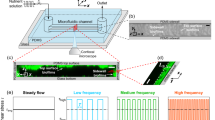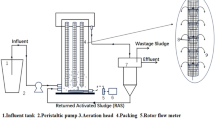Abstract
This protocol describes how to grow a Pseudomonas aeruginosa biofilm under low fluid shear close to the air–liquid interface using the drip flow reactor (DFR). The DFR can model environments such as food-processing conveyor belts, catheters, lungs with cystic fibrosis and the oral cavity. The biofilm is established by operating the reactor in batch mode for 6 h. A mature biofilm forms as the reactor operates for an additional 48 h with a continuous flow of nutrients. During continuous flow, the biofilm experiences a low shear as the media drips onto a surface set at a 10° angle. At the end of 54 h, biofilm accumulation is quantified by removing coupons from the reactor channels, rinsing the coupons to remove planktonic cells, scraping the biofilm from the coupon surface, disaggregating the clumps, then diluting and plating for viable cell enumeration. The entire procedure takes 13 h of active time that is distributed over 5 d.
This is a preview of subscription content, access via your institution
Access options
Subscribe to this journal
Receive 12 print issues and online access
$259.00 per year
only $21.58 per issue
Buy this article
- Purchase on Springer Link
- Instant access to full article PDF
Prices may be subject to local taxes which are calculated during checkout



Similar content being viewed by others
References
Costerton, J.W., Geesey, G.G. & Cheng, K.J. How bacteria stick. Sci. Am. 238, 86–95 (1978).
Costerton, J.W. A short history of the development of the biofilm concept. In Microbial Biofilms (eds. Ghannoum, M. & O'Toole, G.A.) 4–19 (ASM Press, Washington, DC, 2004).
Donlan, R.M. & Costerton, J.W. Biofilms: survival mechanisms of clinically relevant microorganisms. Clin. Microbiol. Rev. 15, 167–193 (2002).
Pereira, M.O., Kuehn, M., Wuertz, S., Neu, T. & Melo, L.F. Effect of flow regime on the architecture of a Pseudomonas fluorescens biofilm. Biotechnol. Bioeng. 78, 164–171 (2002).
Goeres, D.M. et al. Statistical assessment of a laboratory method for growing biofilms. Microbiology 151, 757–762 (2005).
Zelver, N. et al. Measuring antimicrobial effects on biofilm bacteria: from laboratory to field. In Methods in Enzymology Vol. 310: Biofilms (ed. Doyle, R.J.) 608–628 (Academic Press, San Diego, CA, 1999).
Anderl, J.N., Franklin, M.J. & Stewart, P.S. Role of antibiotic penetration limitation in Klebsiella pneumoniae biofilm resistance to ampicillin and ciprofloxacin. Antimicrob. Agents Chemother. 44, 1818–1824 (2000).
Curtin, J.J. & Donlan, R.M. Using bacteriophages to reduce formation of catheter-associated biofilms by Staphylococcus epidermidis . Antimicrob. Agents Chemother. 50, 1268–1275 (2006).
Adams, H. et al. Development of a laboratory model to assess the removal of biofilm from interproximal spaces by powered tooth brushing. Am. J. Dent. 15, 12B–17B (2002).
Xu, K.D., McFeters, G.A. & Stewart, P.S. Biofilm resistance to antimicrobial agents. Microbiology 146, 547–549 (2000).
Xu, K.D., Stewart, P.S., Xia, F., Huang, C.-T. & McFeters, G.A. Spatial physiological heterogeneity in Pseudomonas aeruginosa biofilm is determined by oxygen availability. Appl. Environ. Microbiol. 64, 4035–4039 (1998).
Elkins, J.G., Hassett, D.J., Stewart, P.S., Schweizer, H.P. & McDermott, T.R. Protective role of catalase in Pseudomonas aeruginosa biofilm resistance to hydrogen peroxide. Appl. Environ. Microbiol. 65, 4594–4600 (1999).
Stewart, P.S., Rayner, J., Roe, F. & Rees, W.M. Biofilm penetration and disinfection efficacy of alkaline hypochlorite and chlorosulfamates. J. Appl. Microbiol. 91, 525–532 (2001).
Zheng, Z. & Stewart, P.S. Growth limitation of Staphylococcus epidermidis in biofilms contributes to rifampin tolerance. Biofilms 1, 31–35 (2004).
Method E2647-08 Standard test method for quantification of a Pseudomonas aeruginosa biofilm grown using a drip flow biofilm reactor with low shear and continuous flow. In: Annual Book of ASTM Standards Vol. 11.06 (ASTM International, West Conshohocken, PA 2008).
Method 9050 C.1 buffered dilution water preparation. In: Standard Methods for the Examination of Water and Waste Water. 21st edn. (eds. Eaton, A.D., Clesceri, L.S., Rice, E.W. & Greenberg, A.E.) (American Public Health Association, American Water Works Association, Water Environment Federation, Washington DC, 2005).
Method 9215 heterotrophic plate count. In: Standard Methods for the Examination of Water and Waste Water. 21st edn. (eds. Eaton, A.D., Clesceri, L.S., Rice, E.W. & Greenberg, A.E.) (American Public Health Association, American Water Works Association, Water Environment Federation, Washington DC, 2005).
Herigstad, B., Hamilton, M. & Heersink, J. How to optimize the drop plate method for enumerating bacteria. J. Microbiol. Methods 44, 121–129 (2001).
Acknowledgements
The development and standardization of the drip flow reactor was funded by a grant from The Montana Board of Research and Commercialization Technology.
Author information
Authors and Affiliations
Corresponding author
Ethics declarations
Competing interests
Montana State University retains the intellectual property rights (know-how/ not patented technology) for building the drip flow biofilm reactor. BioSurface Technologies, inc. is the sole licensee of the technology, and pays Montana State University a royalty for the license. The Center for Biofilm Engineering receives a share of the royalty paid to MSU. This money is available to the CBE researchers for continued research in the area of methods development. The dollar amount received by the CBE has been less than $1000/year.
Supplementary information
41596_2009_BFnprot200959_MOESM353_ESM.xls
Supplementary Data 1: Raw data used to calculate the repeatability and variance components of the log density of a Pseudomonas aeruginosa biofilm grown in the drip flow reactor according the protocol presented in this paper. (XLS 54 kb)
Rights and permissions
About this article
Cite this article
Goeres, D., Hamilton, M., Beck, N. et al. A method for growing a biofilm under low shear at the air–liquid interface using the drip flow biofilm reactor. Nat Protoc 4, 783–788 (2009). https://doi.org/10.1038/nprot.2009.59
Published:
Issue Date:
DOI: https://doi.org/10.1038/nprot.2009.59
This article is cited by
-
The non-attached biofilm aggregate
Communications Biology (2023)
-
An overview of various methods for in vitro biofilm formation: a review
Food Science and Biotechnology (2023)
-
The Determination, Monitoring, Molecular Mechanisms and Formation of Biofilm in E. coli
Brazilian Journal of Microbiology (2023)
-
A new BiofilmChip device for testing biofilm formation and antibiotic susceptibility
npj Biofilms and Microbiomes (2021)
-
Establishment of novel in vitro culture system with the ability to reproduce oral biofilm formation on dental materials
Scientific Reports (2021)
Comments
By submitting a comment you agree to abide by our Terms and Community Guidelines. If you find something abusive or that does not comply with our terms or guidelines please flag it as inappropriate.



